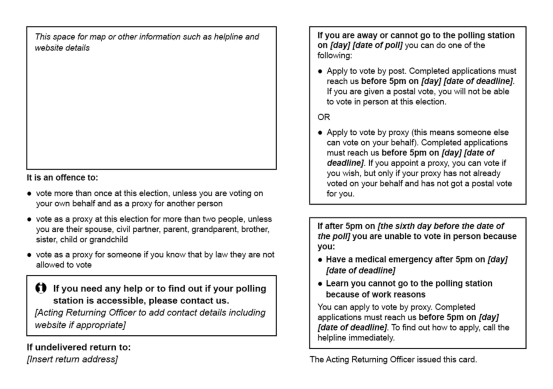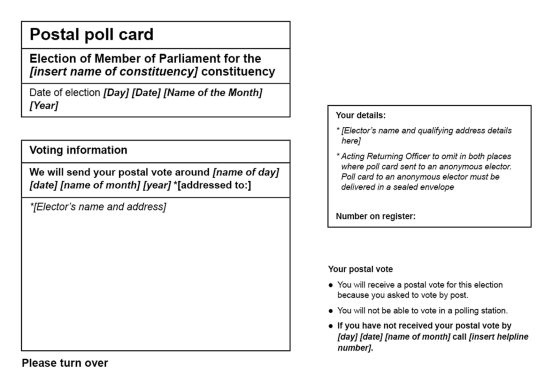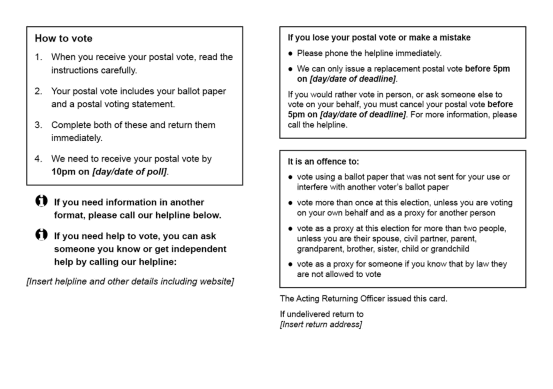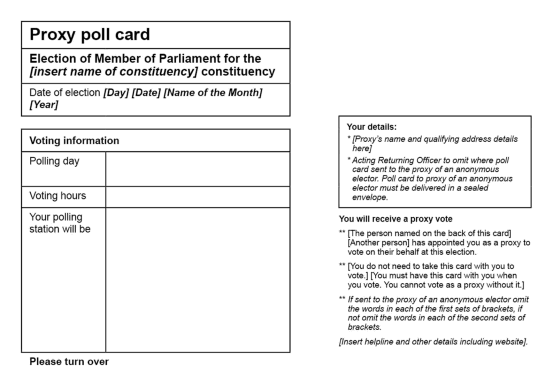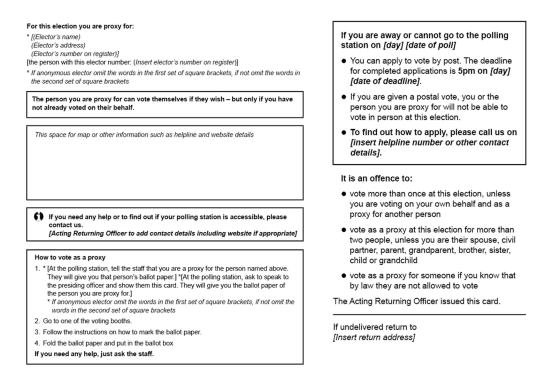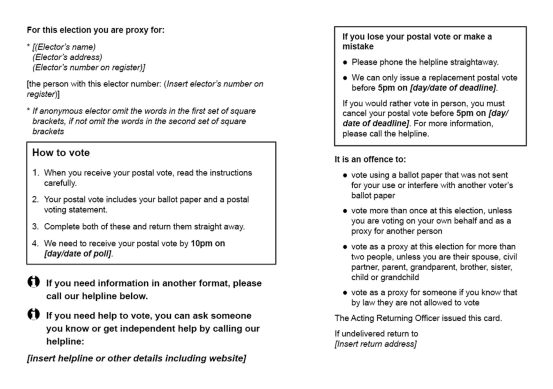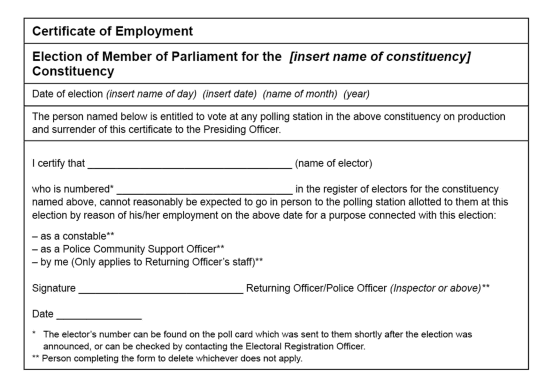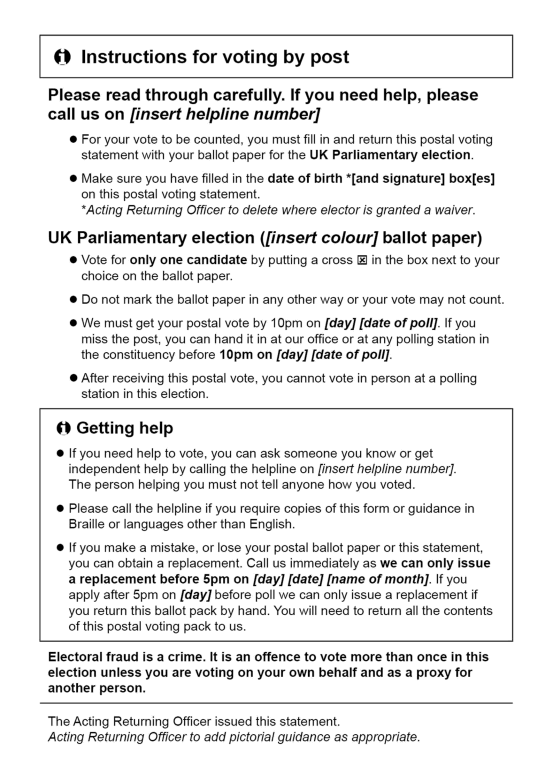- Latest available (Revised)
- Original (As made)
The Representation of the People (England and Wales) (Description of Electoral Registers and Amendment) Regulations 2013
You are here:
- UK Statutory Instruments
- 2013 No. 3198
- Schedules only
More Resources
Status:
This is the original version (as it was originally made). This item of legislation is currently only available in its original format.
Preamble
SCHEDULE 1
These Regulations are made under the following powers:
(a)sections 9B(1)(c)(1), 9E(2), (3) and (6)(2), 10ZC(2) and (3)(3), 10ZD(2) and (3)(4), 10ZE(4) and (6)(a)(5), 53(1), (3) and (4)(6), and 201(1) and (3)(7) of the Representation of the People Act 1983 (“the 1983 Act”)(8);
(b)Schedule ZA1(9), rules 24(10), 28(3) and (3A)(11) and 32(3) of Schedule 1 and paragraphs 1(2)(12) and (2A)(13), 1A(14), 3ZA(15), 5(1B)(16), 5A(17), 8C(18), 10B(19), 11(1) and (2)(20), 12(21) and 13(1ZB)(22) and (1A)(23) of Schedule 2 to the 1983 Act;
(c)having regard to the definition of “prescribed” in section 202(1) of the 1983 Act, section 13AB of that Act(24);
(d)section 3(6)(b) of the Representation of the People Act 1985(25);
(e)having regard to the definition of “prescribed” in section 202(1) of the 1983 Act and paragraph 1(2) of Schedule 4 to the Representation of the People Act 2000(26), paragraphs 4(2) and 6(8) of that Schedule; and
(f)paragraphs 7B(27) and 7E(28) of Schedule 4 to the Representation of the People Act 2000.
Regulation 2
SCHEDULE 2REVOCATIONS
1 Regulations revoked | 2 References | 3 Extent of revocation |
|---|---|---|
| 1. The Representation of the People (England and Wales) Regulations 2001 | S.I. 2001/341 | Regulation 20 |
| 2. The Representation of the People (England and Wales) Regulations 2001 | S.I. 2001/341 | Regulations 81(5)(b), 85 and 85B |
| 3. The Representation of the People (England and Wales) (Amendment) Regulations 2002 | S.I. 2002/1871 | Regulation 14 |
| 4. The Representation of the People (England and Wales) (Amendment) (No.2) Regulations 2006 | S.I. 2006/2910 | Regulations 38, 47(3) to (6) and 65(b)(ii). Regulation 39, insofar as it inserts regulation 85B into S.I. 2001/341. In Schedule 2, Forms A, A1, B, B1, G, H and J. |
| 5. The Representation of the People (Form of Canvass) (England and Wales) Regulations 2006 | S.I. 2006/1694 | The whole of the regulations. |
| 6. The Representation of the People (England and Wales) and the Representation of the People (Combination of Polls) (England and Wales) (Amendment) Regulations 2007 | S.I. 2007/1025 | In regulation 2(4)(a) the words “A, B,” in both places. In the Schedule, Forms A and B. |
Regulation 45
SCHEDULE 3Form of words about the two versions of the register
Short version of the Form of Words
There are two registers. Why?
Using information received from the public, registration officers keep two registers – the electoral register and the open register (also known as the edited register).
The electoral register lists the names and addresses of everyone who is registered to vote in public elections. The register is used for electoral purposes, such as making sure only eligible people can vote. It is also used for other limited purposes specified in law, such as:
detecting crime (e.g. fraud)
calling people for jury service
checking credit applications.
The open register is an extract of the electoral register, but is not used for elections. It can be bought by any person, company or organisation. For example, it is used by businesses and charities to confirm name and address details.
Your name and address will be included in the open register unless you ask for them to be removed. Removing your details from the open register does not affect your right to vote.
Long Version of the Form of Words
There are two registers. Why?
Using information received from the public, registration officers keep two registers – the electoral register and the open register (also known as the edited register).
The electoral register lists the names and addresses of everyone who is registered to vote in public elections.
The register is used for electoral purposes – such as making sure only eligible people can vote – and for other limited purposes specified in law. The personal data in the register must always be processed in line with data-protection legislation.
Who uses the electoral register?
Election staff, political parties, candidates and holders of elected office use the register for electoral purposes.
Your local council and the British Library hold copies that anyone may look at under supervision. A copy is also held by the Electoral Commission, the Boundary Commissions (which set constituency boundaries for most elections) and the Office for National Statistics.
The council can use the register for duties relating to security, enforcing the law and preventing crime. The police and the security services can also use it for law enforcement.
The register is used when calling people for jury service.
Government departments may buy the register from local registration officers and use it to help prevent and detect crime. They can also use it to safeguard national security by checking the background of job applicants and employees.
Credit reference agencies can buy the register. They help other organisations to check the names and addresses of people applying for credit. They also use it to carry out identity checks when trying to prevent and detect money laundering.
It is a criminal offence for anyone to supply or use the register for anything else.
The open register is an extract of the electoral register, but is not used for elections. It can be bought by any person, company or organisation. For example, it is used by businesses and charities to confirm name and address details. The personal data in the register must always be processed in line with data-protection legislation.
Your name and address will be included in the open register unless you ask for them to be removed. Removing your details from the open register would not affect your right to vote.
Who uses the open register?
Users of the open register include:
businesses checking the identity and address details of people who apply for their services such as insurance, goods hire and property rental, as well as when they shop online
businesses selling age-restricted goods or services, such as alcohol and gambling online, to meet the rules on verifying the age of their customers
charities and voluntary agencies, for example to help maintain contact information for those who have chosen to donate bone marrow and to help people separated by adoption to find each other
charities, to help with fundraising and contacting people who have made donations
debt-collection agencies when tracing people who have changed address without telling their creditors
direct-marketing firms when maintaining their mailing lists
landlords and letting agents when checking the identity of potential tenants
local councils when identifying and contacting residents
online directory firms to help users of the websites find people, such as when reuniting friends and families
organisations tracing and identifying beneficiaries of wills, pensions and insurance policies
private-sector firms to verify details of job applicants.
Regulations 46, 47 & 48
SCHEDULE 4FORMS
Arrangement of forms
Form A: Official poll card (to be sent to an elector voting in person)
Form A1: Official postal poll card (to be sent to an elector voting by post)
Form B: Official proxy poll card (to be sent to an appointed proxy voting in person)
Form B1: Official proxy postal poll card (to be sent to an appointed proxy voting by post)
Form F: Certificate of employment
Form G: Postal voting statement (for use at a parliamentary election taken alone)
Form H: Postal voting statement (for use when postal ballots are combined)
Form J: Postal voting statement (for use when a parliamentary poll is combined with another poll but the postal ballots are not combined)
Form A : Official poll card (to be sent to an elector voting in person)Front of card
Back of card
Form A1: Official postal poll card (to be sent to an elector voting by post)Front of card
Back of card
Form B: Official proxy poll card (to be sent to an appointed proxy voting in person)Front of card
Back of card
Form B1: Official proxy postal poll card (to be sent to an appointed proxy voting by post)Front of card
Back of card
Form F : Certificate of employment
Form G : Postal voting statement (for use at a parliamentary election taken alone)Front of statement
Back of statement
Form H : Postal voting statement (for use when postal ballots are combined)Front of statement
Back of statement
Form J : Postal voting statement (for use when a parliamentary poll is combined with another poll but the postal ballots are not combined)Front of statement
Back of statement
Section 9B(1)(c) was inserted by section 10(1) of the Electoral Administration Act 2006 (c. 22).
Section 9E(2), (3) and (6) were inserted by section 5 of the Electoral Registration and Administration Act 2013 (c. 6).
Section 10ZC(2) and (3) were inserted by section 1 of the Electoral Registration and Administration Act 2013 (c. 6).
Section 10ZD(2) and (3) were inserted by paragraph 1 of Schedule 1 to the Electoral Registration and Administration Act 2013 (c. 6).
Section 10ZE(4) and (6) were inserted by paragraph 1 of Schedule 1 to the Electoral Registration and Administration Act 2013 (c. 6).
Section 53(1)(b) was substituted by section 8 of and paragraphs 1and 13(b) of Schedule 1to the Representation of the People Act 2000 (c. 2) ; section 53(3) was amended by paragraph 13 of Schedule 4 to the Representation of the People Act 1985 ( c. 50); section 53(4) was inserted by section 74(1) of and paragraphs 104 and 109 of Part 7 of Schedule 1 to the Electoral Administration Act 2006 (c. 22).
Section 201(3) was inserted by paragraphs 1 and 21 of Schedule 1 to the Representation of the People Act 2000 (c. 2).
Schedule ZA1 was inserted by Schedule 3 to the Electoral Registration and Administration Act 2013 (c. 6).
Rule 24 was substituted by section 37 of the Electoral Administration Act 2006 (c. 22).
Rule 28(3) was amended by paragraphs 69, 70(1) and (3) of Schedule 1 to the Electoral Administration Act 2006 c. 22.
Paragraph 1(2) was amended by section 13(1) of and paragraphs 1, 20(1) and (2)(a) of Schedule 4 to the Electoral Registration and Administration Act 2013 (c. 6).
Paragraph 1 (2A) was inserted by section 2 of and Schedule 2 to the Electoral Registration and Administration Act 2013 (c. 6).
Paragraph 1A was inserted by section 2 of and Schedule 2 to the Electoral Registration and Administration Act 2013 (c. 6).
Paragraph 3ZA was inserted by section 2 of and Schedule 2 to the Electoral Registration and Administration Act 2013 (c. 6).
Paragraph 5(1B)was inserted by section 10(2) and paragraphs 2, 15(1) and (5) of Schedule 1 to the Electoral Administration Act 2006 (c. 22).
Paragraph 5A was inserted by Schedule 2 to the Representation of the People Act 1985 and amended by paragraphs 3 and 11 of Schedule 6 to the Representation of the People Act 2000 (c 2).
Paragraph 8C was inserted by section 2 of and Schedule 2 to the Electoral Registration and Administration Act 2013 (c. 6).
Paragraph 10B was inserted by section 9 of the Representation of the People Act 2000 (c. 2).
Paragraph 11 was substituted by section 9 of the Representation of the People Act 2000 (c. 2).
Paragraph 12 was amended by paragraphs 69 and 94 of Schedule 1 to the Electoral Administration Act 2006 (c. 22).
Paragraph 13(1ZB) was inserted by section 2 of and Schedule 2 to the Electoral Registration and Administration Act 2013 (c. 6).
Paragraph 13(1A) was inserted by section 9 of the Representation of the People Act 2000 (c. 2).
Section 13AB was inserted by section 16 of the Electoral Registration and Administration Act 2013 (c. 6).
Paragraph 7B was inserted by section 14 of the Electoral Administration Act 2006 (c. 22).
Paragraph 7E was inserted by section 22 of the Electoral Registration and Administration Act 2013 (c. 6).
Options/Help
Print Options
PrintThe Whole Instrument
PrintThe Schedules only
Legislation is available in different versions:
Latest Available (revised):The latest available updated version of the legislation incorporating changes made by subsequent legislation and applied by our editorial team. Changes we have not yet applied to the text, can be found in the ‘Changes to Legislation’ area.
Original (As Enacted or Made): The original version of the legislation as it stood when it was enacted or made. No changes have been applied to the text.
Explanatory Memorandum
Explanatory Memorandum sets out a brief statement of the purpose of a Statutory Instrument and provides information about its policy objective and policy implications. They aim to make the Statutory Instrument accessible to readers who are not legally qualified and accompany any Statutory Instrument or Draft Statutory Instrument laid before Parliament from June 2004 onwards.
More Resources
Access essential accompanying documents and information for this legislation item from this tab. Dependent on the legislation item being viewed this may include:
- the original print PDF of the as enacted version that was used for the print copy
- lists of changes made by and/or affecting this legislation item
- confers power and blanket amendment details
- all formats of all associated documents
- correction slips
- links to related legislation and further information resources
More Resources
Use this menu to access essential accompanying documents and information for this legislation item. Dependent on the legislation item being viewed this may include:
- the original print PDF of the as made version that was used for the print copy
- correction slips
Click 'View More' or select 'More Resources' tab for additional information including:
- lists of changes made by and/or affecting this legislation item
- confers power and blanket amendment details
- all formats of all associated documents
- links to related legislation and further information resources

